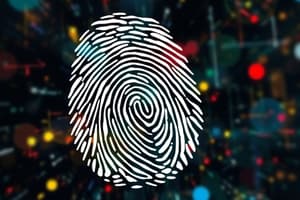Podcast
Questions and Answers
What percentage of the population has arch fingerprint patterns?
What percentage of the population has arch fingerprint patterns?
- 65%
- 30%
- 5% (correct)
- 10%
Which fingerprint technique would you use on dark-colored, hard, non-absorbent surfaces?
Which fingerprint technique would you use on dark-colored, hard, non-absorbent surfaces?
- Fluorescent Powder (correct)
- Magnetic Powder
- Black Powder
- Ninhydrin
What is the function of the basal layer in fingerprint formation?
What is the function of the basal layer in fingerprint formation?
- To generate fingerprints (correct)
- To create visible prints
- To provide grip
- To identify individuals
Which of the following prints are visible without any special techniques?
Which of the following prints are visible without any special techniques?
What is the purpose of ridges in fingerprints?
What is the purpose of ridges in fingerprints?
When do fingerprints begin to develop during pregnancy?
When do fingerprints begin to develop during pregnancy?
Which option describes an incorrect characteristic of fingerprint loops?
Which option describes an incorrect characteristic of fingerprint loops?
Which method is used to reveal fingerprints on metals or glass?
Which method is used to reveal fingerprints on metals or glass?
Flashcards
Core
Core
The center point of a whorl or loop fingerprint pattern.
Delta
Delta
Triangular regions near a loop or whorl, where ridge lines diverge.
What are dermal ridges?
What are dermal ridges?
The raised portions of a fingerprint, arranged in connected units, providing grip and enhancing friction.
Patent Print
Patent Print
Signup and view all the flashcards
Latent Print
Latent Print
Signup and view all the flashcards
AFIS
AFIS
Signup and view all the flashcards
Black Powder Technique
Black Powder Technique
Signup and view all the flashcards
Ninhydrin Technique
Ninhydrin Technique
Signup and view all the flashcards
Study Notes
Fingerprint Characteristics
- Fingerprints develop during fetal development at approximately 10 weeks of pregnancy.
- Dermal ridges are the raised portions of a fingerprint, arranged in connected units for enhanced grip.
- Minutiae are the ridge characteristics that distinguish each fingerprint and make it unique.
Fingerprint Types
- Arches (5%): Ridges enter on one side and exit the other; can have one delta. Subtypes include plain and tented arches.
- Loops (65%): Ridges enter on one side and exit on the same side, with one delta. Subtypes include ulnar loops (tail points towards the pinky finger) and radial loops (tail points towards the thumb).
- Whorls (30%): Have a circular or spiral pattern with two deltas. Subtypes include plain, central pocket, double-loop, and combination whorls.
Fingerprint Types (detailed info)
- Core: Center of a loop or whorl
- Delta: Triangular regions near a loop or whorl
- Ridge count: The number of ridges counted from the core to the edge of a delta.
Types of Prints
- Patent prints: Visible prints transferred onto a smooth surface by a liquid (e.g., a bloody print).
- Latent prints: Invisible prints that need techniques to visualize, like dusting or chemicals (e.g., fingerprints found on a coffee mug).
- Impression prints: Indentations left in soft materials like wax or soap (e.g., an imprint in a soap bar).
Fingerprint Databases
- AFIS (Automated Fingerprint Index System): A large FBI database used to identify fingerprints.
Latent Print Development Techniques
- Black powder: Used on hard, non-absorbent, light-colored surfaces. Use a fluffy brush and twirl over the area, then lift with transparent tape.
- Fluorescent powder: Used on hard, non-absorbent dark-colored surfaces. Use a magnetic wand to apply and lift the magnetic powder.
- Cyanoacrylate: Used on household items (metals, glass, skin). Vaporizes to reveal prints when left in a closed container.
- Ninhydrin: Used on paper or cardboard; reveals a pink/purple reaction.
- Silver Nitrate: Used on wood or Styrofoam.
- Iodine fuming: Used on paper, cardboard, or unpainted surfaces; reveals a yellow reaction. Use in a closed container for vaporization.
Studying That Suits You
Use AI to generate personalized quizzes and flashcards to suit your learning preferences.




